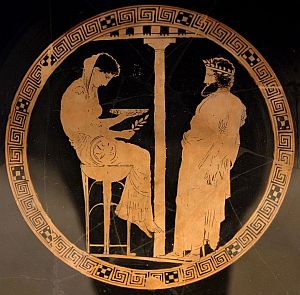Why Not be Anti-Semiotic?
From The American SpectatorThe late Professor Geoffrey Shepherd of the University of Birmingham in England, at whose feet I sat for a time back in the 1970s, once observed that for medieval Christians the central event in human history had not been the Crucifixion or the Resurrection but the Harrowing of Hell. Today, this unscriptural doctrine, though it has never been disavowed, is preserved only in the Apostles’ Creed (“He descended into Hell.”), but its significance for centuries of Christians tells us something important about them — for instance, their understanding of how vital are the links between the Old Covenant and the New. Just lately, however, the Crucifixion has again fallen into eclipse. But now the central event in human history, at least to judge by Mel Gibson’s The Passion of the Christ, is the Flagellation administered to Jesus by the Romans before the Crucifixion — which in the film is reduced to an anticlimax.
Naturally, there is no mention of the Harrowing of Hell. There is barely one of the Resurrection. But Mel’s film seems to me to be as revealing about our own times as the emphasis on Christ’s descent into Hell is about the Middle Ages. The semiotics of movie blood since, oh, say Bonnie and Clyde (1967) or The Wild Bunch (1969) has been bound up with the thrill of the forbidden. We persist in believing that to peep behind the veil of decorum is to observe something real. Thus even A.O. Scott of the New York Times, who didn’t like the film, concedes that it is disturbingly real. “By rubbing our faces in the grisly reality of Jesus’ death and fixing our eyes on every welt and gash on his body, this film means to make literal an event that the Gospels often treat with circumspection and that tends to be thought about somewhat abstractly.”
Excuse me, but on what basis is this gory spectacle supposed to be “reality”? The Bible tells us only that Jesus was scourged. You’d think somebody would have said something more than that about the event if He had been virtually flayed alive as he is in Gibson’s film. But Scott means “reality” in the same way that Gibson does, I think. That is to say, he means movie reality. It is the movies that have taught us that the more blood we see the more “real” it is. Political and religious conservatives, disdaining as they do the vulgarity and trashiness of the popular culture, have some excuse for thinking this way because they don’t go to movies very often. They might be a bit slow to recognize that this kind of slow-mo, blood-spattered violence owes less to Caravaggio — whom Gibson claims to have taken as his model — than it does to Sam Peckinpah.
But to those of us who have been watching this kind of thing for over thirty years it looked much more familiar — so much so that to me it seemed old-fashioned and unreal. Wheezy and cheesy, as you might say. Or, as Maureen Dowd of the New York Times put it, the movie “has the cartoonish violence of a Sergio Leone Western. You might even call it a spaghetti crucifixion, ‘A Fistful of Nails’.” Is it, I wonder, entirely coincidental that the days when the victims of movie violence simply keeled over, said a few last words and expired decorously with not a mark on them, save perhaps for a slight bruise (no swelling) on their forehead, ended almost simultaneously with the kind of Tridentine Catholicism that Mel is said to be bringing back? Could there be any connection between the 30 or 40 years’ growth of blood-lust among movie-goers and the fact that Hollywood’s image of the Church has progressed over the same period from The Sound of Music (1965) to The Magdalene Sisters of last year?
I also wonder if some of the Christians, evangelical as well as Catholic, who have celebrated The Passion haven’t been flattered into thinking that the full movie treatment of their sacred mysteries means that they are somehow hip again, their faith included in the celebrity “lifestyle” from which Christian piety has for at least a generation been rigidly excluded. I don’t mean to be contemptuous of those who want to be loved by Hollywood. Christianity has throughout its history been a popular religion. The Good News of the Gospel was intended for a mass audience. When the media that serve such an audience in our time came to regard it as a religion of nuts and killers and rednecks and child-abusers, it was not only wounding but it called into question the very foundations of the faith and the self-identification of its adherents. Yet although Gibson’s stress on the promiscuous spattering of blood and flesh on Jesus’s torturers and other by-standers and observers — let us spray, quoth Mel — doubtless arose out of his devotion to the faith, it had the effect of re-integrating Christianity into the pop-cultural mainstream only at the cost of aligning itself with the cult of victimhood which the movies have done so much to promote.
True, this Christ is, like the Fisher King on whom He is said by some to be based, a victim-hero who may be strengthening to the faith of many. But it shouldn’t be forgotten, either, that our empathetic response is meant to be with the torturers and not with their victim, which goes clean contrary to the broader tendency of the victim-culture on which the film so largely depends. Mel Gibson recognized this and put things back in perspective when he had his own hand photographed driving in one of the nails, but most people watching will feel the scourge on their own backs and be moved not to repentance but to self-pity, as they are in other cinematic representations of pain and suffering. It is the tendency of the medium — so “real,” so immediately engaging — and cannot be wished away because the medium is being used to represent events with spiritual meaning.
Within a day or two of the opening of The Passion of the Christ I happened to watch another film based on images of a young man being tortured almost to death and reduced to a mere husk of humanity by nearly unimaginable suffering. Kevin McDonald’s Touching the Void, the Movie of the Month, I found to be a much more spiritually edifying experience, even though it explicitly disavows having a religious meaning, or even that there is such a thing in the world. Based on a true story about a climbing accident in the Andes in 1985, it presents its own hero-victim, Joe Simpson, merely describing his experiences to the camera, as an unscarred talking head, while an actor portrayed in dumb-show their high points.
It sounds hokey, but somehow it isn’t. After reaching the summit of a hitherto unclimbed peak with his climbing partner, Simon Yates, Simpson had badly broken his leg on the descent. As Yates was lowering him on a rope in a snowstorm, he went over a ledge and could neither go back up nor further down, nor could he alert his partner who was 150 feet above him. After some time during which the day grew darker and the storm worse and he began to feel himself being pulled off the mountain, Yates cut the rope. Incredibly, Simpson survived, though only after days of crawling and dragging himself, when every foot was agony, over miles of glacier, moraine and icefield.
Simpson tells us that he was raised a devout Roman Catholic and, having lost his faith, wondered if it would occur to him to say a prayer when death was all but certain, as it was on more than one occasion. It never did. Yet there was something more stirring to the spirit about his experiences than all the tawdry cinematic gore of The Passion. Here was an image of hope and despair, the latter particularly in the look on Joe Simpson’s face as he described that awful instant, just before his rescue, when he thought Yates had broken camp and left, thinking him dead, and that all his efforts had been for nothing. “There was a moment when no one answered the call — ” he says, oddly recalling a similar moment on the cross, and when “I lost something. I lost me.” Now there’s a cinematic representation of reality.
Discover more from James Bowman
Subscribe to get the latest posts to your email.







